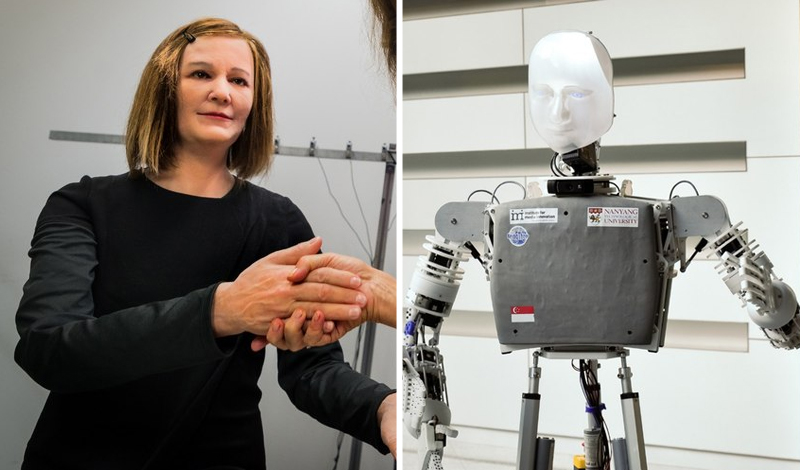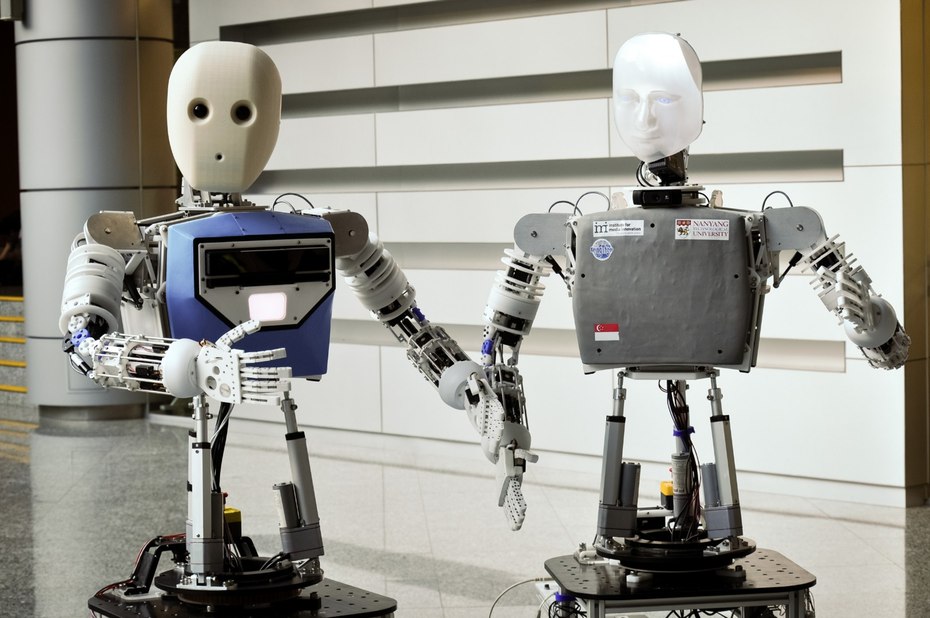
1st January 2016 New social and telepresence robots developed in Singapore Two new humanoid robots have been demonstrated by researchers at Nanyang Technological University (NTU) in Singapore.
Say hello to Nadine – a “receptionist” at Nanyang Technological University in Singapore. She is friendly, and will greet you back. Next time you meet her, she will remember your name and your previous conversation with her. She looks almost like a human being, with soft skin and flowing brunette hair. She smiles when greeting you, looks at you in the eye when talking, and can also shake hands with you. Unlike most conventional robots, Nadine has her own personality, mood and emotions. She can be happy or sad, depending on the conversation. She also has a good memory, can visually recognise the people she has met and remember what the person had said before. Nadine is the latest social robot developed by scientists at NTU. The doppelganger of its creator, Prof Nadia Thalmann, Nadine is powered by intelligent software similar to Apple’s Siri and Microsoft’s Cortana. In the future, robots like Nadine could be used as personal assistants in the office, or used as social companions for the young and the elderly at home. A humanoid robot like Nadine is just one of the interfaces where NTU's technology can be applied. It can also be made virtual and appear on a TV or computer screen, and become a low-cost virtual social companion. With further progress in robotics driven by technological improvements in silicon chips, sensors and computation, physical social robots like Nadine are poised to become more visible in offices and homes in the coming decades.
A second robot – known as EDGAR – was also demonstrated at NTU’s new media showcase. EDGAR is available in two different configurations as shown in the videos below. The first allows him to autonomously deliver speeches and read from a script. With an integrated webcam, he automatically tracks the people he meets to engage them in conversation, giving informative or witty replies to questions. This makes him ideal for use at public venues like tourist attractions and shopping centres, where he can offer practical information to visitors. The other configuration allows EDGAR to become a tele-presence robot, optimised to replicate the movements of a human user. By standing in front of a specialised webcam, the user can control EDGAR remotely from anywhere in the world. Their face and expressions are projected onto the robot’s face in real time, while the robot mimics the person’s upper body movements, which include two highly articulated arms.
Led by Prof Gerald Seet, from the School of Mechanical and Aerospace Engineering, this robot is the result of three years of research and development: “EDGAR is a real demonstration of how telepresence and social robots can be used for business and education,” explains Seet. “Telepresence provides an additional dimension to mobility. The user may project his or her physical presence at one or more locations simultaneously, meaning that geography is no longer an obstacle. “In future, a renowned educator giving lectures or classes to large groups of people in different locations at the same time could become commonplace. Or you could attend classes or business meetings all over the world using robot proxies – saving time and travel costs.” Given that some companies have expressed interest in the robot technologies, the next step for these NTU scientists is to look at how they can partner with industry to bring them to the market.
The Nadine and EDGAR robots are among NTU’s many exciting innovations that companies can leverage for commercialisation, Professor Thalmann says: “Robotics technologies have advanced significantly over the past few decades and are already being used in manufacturing and logistics. As countries worldwide face challenges of an aging population, social robots can be one solution to address the shrinking workforce, become personal companions for children and the elderly at home, and even serve as a platform for healthcare services in future.” “Over the past four years, our team at NTU have been fostering cross-disciplinary research in social robotics technologies – involving engineering, computer science, linguistics, psychology and other fields – to transform a virtual human, from within a computer, into a physical being that is able to observe and interact with other humans. “This is somewhat like a real companion that is always with you – and conscious of what is happening. So in future, these socially intelligent robots could be like C-3PO, the iconic golden droid from Star Wars, with knowledge of language and etiquette.”
Comments »
|








